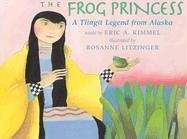Our next tribe to learn about was the Tlingit. The Tlingit live in the Northwestern areas of Canada and the Alaskan peninsula.
We started by reading a couple of books about the Tlingit. Children of the Tlingit was a good general fact book, and had a lot of information about their lives today.

We also read The Frog Princess, A Tlingit Legend from Alaska. George thought he knew how the story would go and was glad when it was different than he expected.

The kids then colored in the pocket pages from Evan Moor History Pockets, while I read through the information pages.` Once they were done, Vicki glued hers onto paper to make a notebook page, while George’s were added to our chart.
The Tlingit wore potlatch hats and Chilkat robes for special occasions. They wore animal skin and leather pants, earrings and nose rings. They ate salmon and other fish, sea lion, otter, goat, bear, and elk. They made totem poles representing their family group, and lived in plank long houses.
The kids made their own totem poles using pictures I found through Dover coloring books (they have quite a few free samples on the website) and Paper Totem Poles. The kids each picked out two totems to color and add to their poles. The poles were made by taping two old peanut butter jars together and covering with construction paper.
Even Vicki actually took some time to color hers in neatly and with more than one crayon.
While the kids were coloring in their totem poles, I worked on putting together a paper Northwest Coast Cedar House model I found through Pinterest.
The kids spent quite a bit of time playing with the house, their totem poles, and the Native American paper dolls we have from Dover.
George finished up by adding a few facts to his “research notebook” which has been upgraded from a legal pad to a composition notebook.
I’m not sure which tribe we will do next. On the schedule is Nez Perce, but George is pushing for the Sioux or the Navajo.




Their Totem Poles look great :-)
ReplyDelete